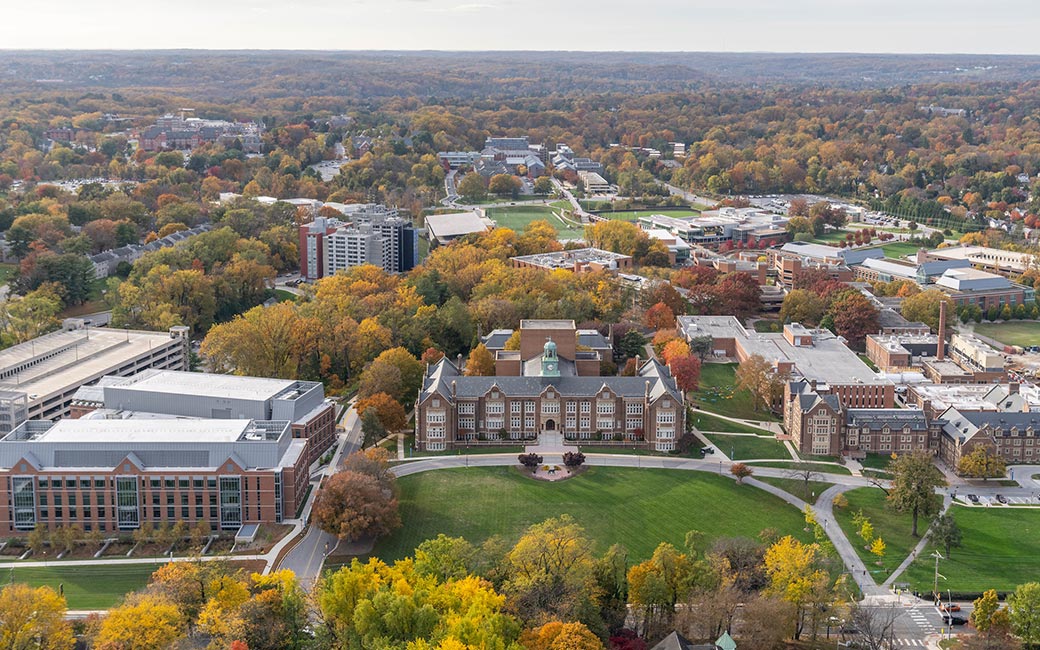How to share a thoughtful, personalized land acknowledgment
Office of Inclusion & Institutional Equity answers questions about TU’s land acknowledgment and how it can be used
By Bethany Pace on November 2, 2022

During Native American Heritage Month—celebrated annually in November—and throughout the year, Towson University’s Office of Inclusion & Institutional Equity (OIIE) provides resources to guide the community in awareness, understanding and action around the Native peoples of the region and the land on which we reside.
This is in conjunction with the university’s Diversity Strategic Plan, which aims to tell a more complete, complex and reconciled history of TU, the region and the state by including the perspectives and accomplishments of all constituents, especially those who may have been erased previously.
Below, OIIE’s Brian Jara, assistant director of diversity training and education, and Gabriel Ortiz ’23, Native/Indigenous student research assistant, answer questions about a land acknowledgment statement’s purpose, the creation of TU’s statement and how to thoughtfully incorporate the practice into your next gathering.
More information regarding the process is in planning and will be shared with the campus in the coming months.
What is a land acknowledgment?
An acknowledgment of the land is rooted in Indigenous practices and includes a formal statement that recognizes the unique and enduring relationship that exists between Indigenous peoples and their traditional territories. It is grounded in recognition and respect, supports truth-telling and reconciliation and creates a broader public awareness of the history that has led to this moment. Land acknowledgments are prepared in advance and often are written or spoken statements but can also be delivered through other media or forms of expression.
What does a land acknowledgment ask of us?
A land acknowledgment asks each of us to create a long-term plan of action to support Indigenous communities in the future. This begins with researching the Indigenous people to whom the land belongs and understanding the history of the land.
- To understand the language, history and current events regarding the land-designated tribes.
- To have an independent identity and perspective that shares the values of Indigenous peoples.
Why should we consider offering land acknowledgments?
It is an opportunity for each of us to increase our awareness, reflection and plan for action regarding the history of the land on which you reside and the Native peoples of the region. Most importantly, it must be more than a template statement read aloud at an event or included in a presentation without deeper consideration of its meaning nor plan for realistic action steps.
Land acknowledgments should be substantial in significance and meaning. We offer land acknowledgments to understand the origin of the aboriginal peoples. It opens our perspectives to important history that has been overshadowed and gives actionable information regarding the past, present and future of tribal nations.
Does TU have a land acknowledgment statement?
OIIE provides several online resources to guide TU community members through a process of reflection and understanding. Following these initial steps is essential for developing thoughtful and personalized language to accompany the university’s statement, which reads:
“Towson University seeks to cultivate relationships with Native American and Indigenous communities and nations through academic pursuits, partnerships, historical recognitions, community service and enrollment efforts. These communities and nations include the Susquehannock (suh-skwuh-ha-naak), Nanticoke (nan-tuh-kowk) and the Piscataway (puh-ska-tuh-way) people who consider the land that the university currently occupies part of their ancient homeland.”
OIIE recommends sharing a personalized introduction before the TU statement and incorporating a conclusion that provides a connection to the specific event or activity being convened. For example, if you are presenting on behalf of your work in a certain field or discipline, highlight Indigenous people who have contributed to the body of knowledge in that subject area.
The portion of your acknowledgment that pays tribute to the Indigenous people of the land TU currently resides on should follow the guidance provided by OIIE, who continues to conduct research and cultivate relationships with local tribes and compensate elders for their time and their willingness to share their experiences.
When might members of TU’s campus community make a land acknowledgment?
Land acknowledgments can be shared at the beginning of public and private gatherings and should be motivated by genuine respect, support and willingness to take action on behalf of Native peoples.
- Land acknowledgments must be communicated and affirmed from leadership officials and implemented throughout the norms and values of the institution.
- Land acknowledgments should also be included on websites and social media pages.
- Games, events, meetings and other community gatherings should share a land acknowledgment to seed the ongoing existence of a dedicated community to protect the land.
What resources and/or knowledge exist to inform our understanding of Native American and Indigenous peoples in Maryland and beyond?
OIIE will continue to provide resources and opportunities for our entire TU community to reflect, converse and identify meaningful ways to recognize Indigenous Peoples’ Day, acknowledge the land now occupied by Towson University and continue this work throughout the year.
Guidance and resources will continue to be shared with campus through the Office of Inclusion and Institutional Equity.